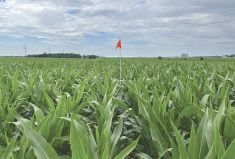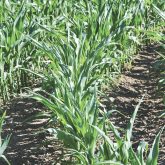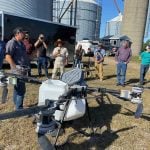Four years ago we heard predictions of 10 million acres of corn in Western Canada by 2026, but it turns out that they have yet to launch on that trajectory. Grain corn acreage in Manitoba, Saskatchewan and Alberta peaked in 2017 and remained between 470,000 to 480,000 acres for the next two years. While this year’s final figures were not available at time of writing, earlier seeding intentions suggested Prairie grain corn acreage would be down by about 13 per cent.
Last year’s harvest conditions after early snowfall in Manitoba and Alberta and a slow, wet start to this season played a big role in that decline.
Read Also

Agronomists share tips for evaluating new crop products and tech: Pt. 3
With new products, new production practices and new technology converging on the agriculture industry at a frenetic pace in recent…
“Corn acres are most certainly down this year because of conditions last fall and this spring,” says Morgan Cott, field agronomist for the Manitoba Corn Growers Association. “There are producers who knew it would be a challenging spring and decided to remove corn this year to ease the load, especially if they couldn’t get on to the fields that were best suited for corn this year.
“Grain corn is a lot of work in the spring and the fall. We have had several years in a row with good fall weather that has allowed us to harvest well into November without much issue. Last fall was a very challenging harvest, and it is possible some producers want to avoid that for one year.”
Lower prices also made growers question the profitability of growing corn this year.
“If you think about the profitability of a corn acre planted in Manitoba, a grower might get bids around $4/bu. versus wheat that’s $6/bu. to $7/bu. and canola is still at a good profitability level,” says Jeff Loessin, Corteva AgriScience corn and soybean marketing lead for Canada. “It probably impacts growers’ willingness to grow corn on more acres in that situation, and it also changes their investment equation.”
Growing corn, whether it’s for grain, forage or grazing, also requires extra investments in things such as planters, headers, choppers, dryers or fencing.
Loessin believes the introduction of carbon taxes could have dampened some enthusiasm for growing grain corn too, especially since growers typically need a grain dryer. “The carbon tax adds extra costs that farmers are still trying to figure out, which loops back to profitability,” he says.
The pandemic has also affected Canadian and U.S. corn acres. “When COVID-19 hit and oil prices slumped, ethanol demand went down,” Loessin says. “That made growers ask ‘how much corn do I really need to grow or should I grow because of the downside risk on profitability?’”
Mark Kerry, crop and campaign marketing manager for corn with Bayer CropScience, agrees.
“Probably short-term there’s a role that COVID has played in corn acres, and because it’s a heavy investment in fertilizer, seed and crop protection, there may be some producers going back to barley in their feed rotation or rations for their livestock. But we fully expect corn acres are going to increase again in 2021, although factors around commodity price and feedstock conditions are going to continue to play a role.”
Breeding programs continue
While there may not be as much corn in the ground this year, major companies say they remain committed to increasing the corn footprint across Western Canada and are investing heavily in local breeding programs and agronomy trials.
“We continue to breed and test corn in Western Canada,” Loessin says. Corteva has active breeding programs in Carman, Lethbridge and Saskatoon. “The drive is to figure out the traits and the qualities that we need for Western Canada, and by doing the research here, we ensure any hybrids or germplasm are suitable from a trait standpoint and are adapted for growing conditions in Western Canada.”
Corteva’s agronomy research includes trials looking at plant population and row width to optimize yields under various conditions, and building recommendations for different regions.

Bayer has a pre-commercial testing program for the new genetics it develops for Western Canada and has eight market development farms in the region with close to 100 ongoing agronomy trials for both grain and silage corn.
“All of these are designed to bring…lower-heat unit, earlier-season genetics to Western Canada which best fit into silage and grain corn markets, as well as dual-purpose hybrids that fit both,” Kerry says.
Kerry says digital tools such as Bayer’s Climate Fieldview will help make better agronomic recommendations.
“Tools like this will play a role in growth of corn acres in Western Canada long-term.”
Although 10 million acres might be overly optimistic, Loessin says there are still plenty of opportunities for growth, but profitability will determine adoption.
“Our jobs are to provide products that perform and to help growers understand how corn can be profitable on their farms, so that’s where we’re putting our investment, in making sure that local testing is done, so that customers can make decisions on what corn hybrid to grow and their agronomic practices based on local data.”
What’s new in breeding programs?
Corteva says yield remains the main focus for its western Canadian breeding program, but it also includes resistance to mid-season brittle snap, root lodging and late-season stalk lodging. Moving into non-traditional corn-growing regions with lower heat units is still a major objective, with an emphasis on driving genetic gain for early maturity.
Corteva’s lead corn breeder Travis Coleman says its lineup currently includes the earliest-maturity hybrids available in the market but a goal is to develop even earlier hybrids that can reliably reach physiological maturity in under-2000 CHU regions such as central Alberta and Saskatchewan.
The main disease concern is Goss’s wilt, which is appearing not only in traditional corn-growing regions but also in isolated, non-traditional areas, suggesting the bacterium is endemic to the Prairies. “Corteva germplasm has adequate native genetic resistance available to deploy through traditional breeding and to provide resistance,” Coleman says.
The requirement for most of Western Canada is the development of ultra-early maturity hybrids. Most of the germplasm will be produced through a process called “transgressive segregation” (selection of progeny that are earlier than either parent). Coleman says that represents a challenge as it pushes the germplasm beyond what has existed before.
“Balancing this development of earliest-maturing genetics while providing top end yield performance is a challenge that is unique to the geography. Our early-maturity germplasm collection provides the genetic diversity needed and a strong base to build on.”
This season, Bayer CropScience introduced its earliest corn hybrid in the DEKALB lineup, DKC21-36RIB, a 71-day hybrid that can be grown farther north and west. “It’s a nice fit into parts of Alberta and Saskatchewan where our customers have not been able to grow corn before because we didn’t have early enough genetics for their regions,” Kerry says.
Bayer continues to focus on bringing value-added traits into its earlier hybrids. An example is its SmartStax system, with below- and above-ground insect control together with Roundup Ready and Liberty Link, making it an eight-way traited corn.
“It would just be a fit for southern Manitoba, but it’s an example of new innovative traits getting earlier in our lineup,” Kerry says. Also, in Bayer’s seed guide for Western Canada is a Trecepta Rib Complete, which offers an above-ground insect protection trait that controls Western bean cutworm, although this isn’t yet a pest affecting Western Canada.
Corteva has several under-2000 CHU hybrids in late-stage development and will offer trait packages in AcreMax above-ground Bt protection or Roundup Ready herbicide resistance. “These hybrids will open up new acres in non-traditional growing regions where heat unit accumulation has historically been a limiting factor to grain corn cultivation and will provide expanded options for silage production,” Coleman says. “A selection of hybrids with Qrome below-ground protection will also become available to support acres where rootworm resistance is desirable.”
Corteva breeders are also working on a new above-ground insect control trait called PowerCore Enlist, which will be of value for weed control for growers across Western Canada whose weed control options for corn are more limited than in the East. “The Enlist weed control trait makes corn fully tolerant to 2,4-D along with glyphosate,” Loessin says. For weed control, Western Canadian growers can get at things like volunteer canola, wild buckwheat, dandelion and thistle with that technology.”
Bayer says it’s also working on new corn seed treatments and is looking at launching a couple of new herbicides in Western Canada over the next two to three years.
This article originally appeared in the September 2020 issue of the Corn Guide.
















